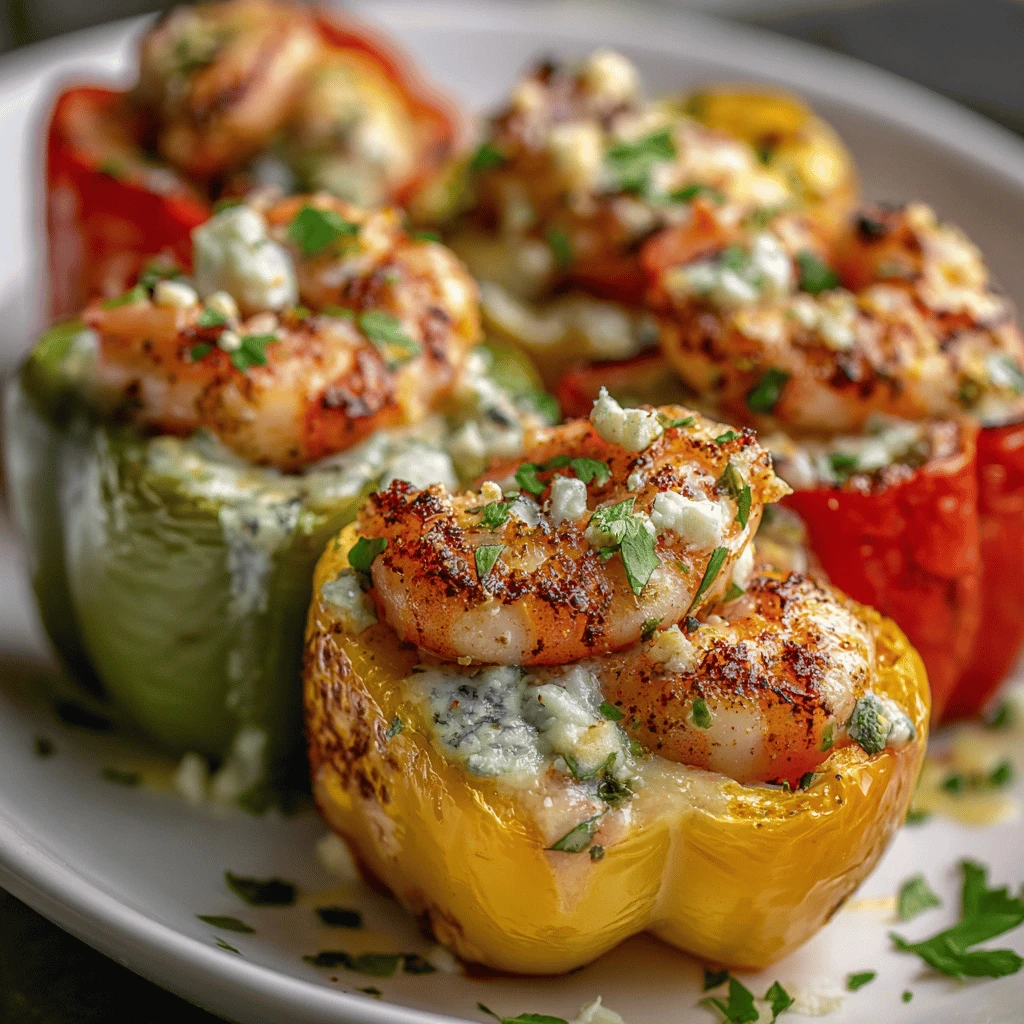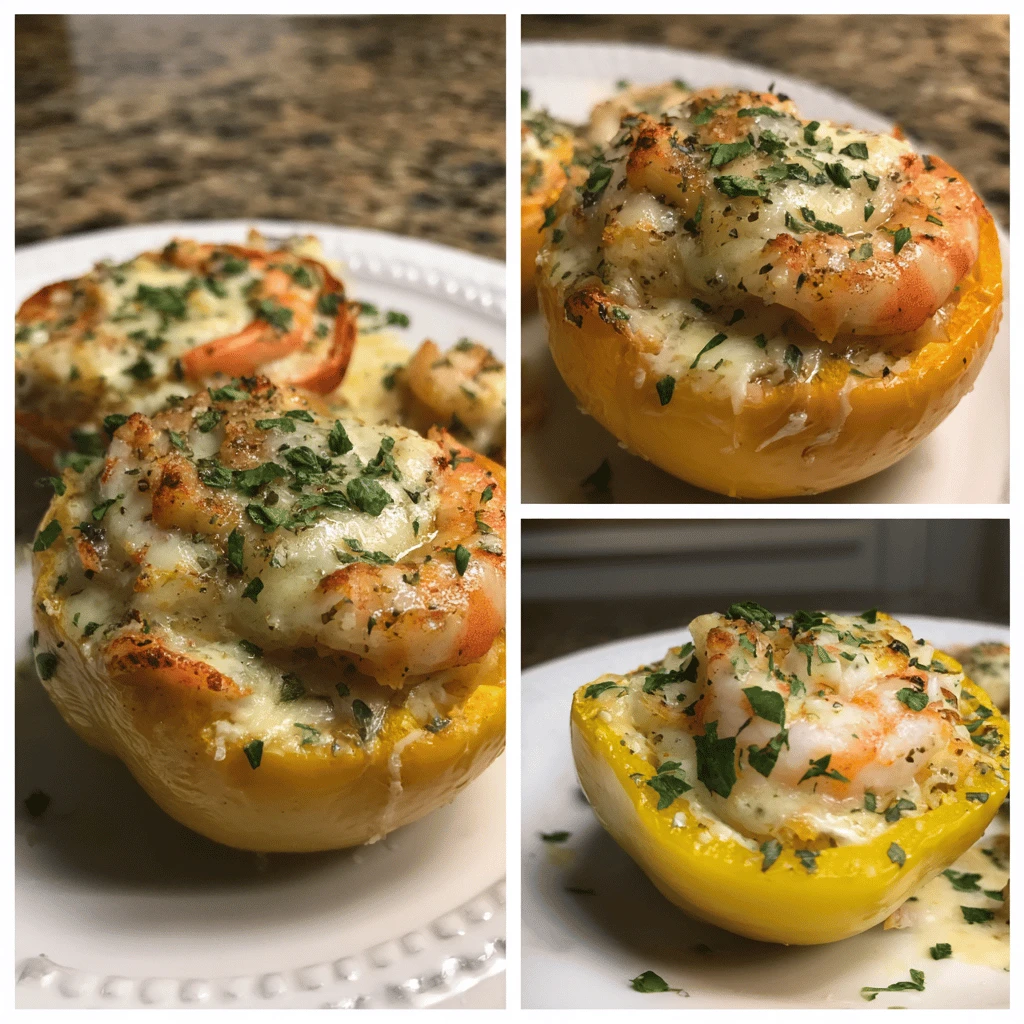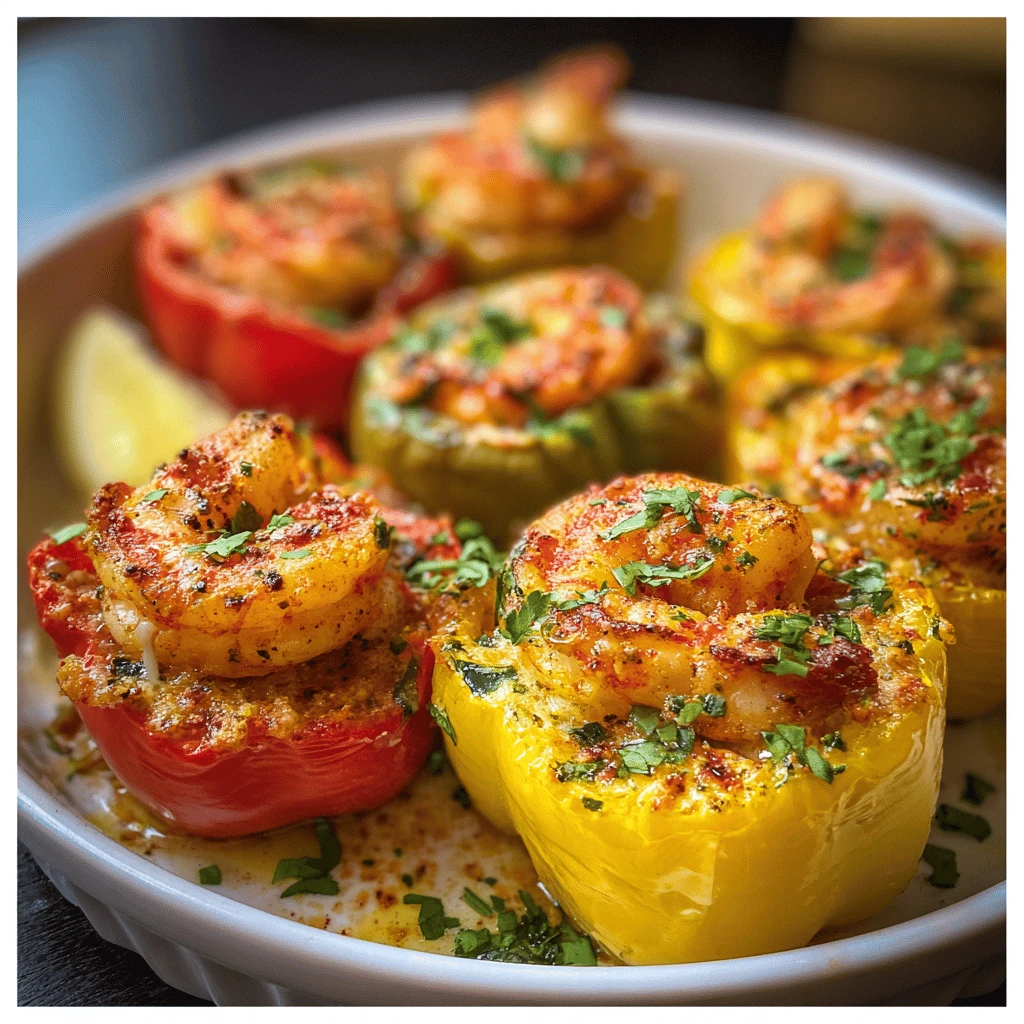Keto-Friendly Low Carb Shrimp Stuffed Peppers
Shrimp stuffed peppers are a delicious and satisfying meal that can easily be adapted to fit a ketogenic and low-carb lifestyle. Combining the fresh flavors of shrimp with the mild sweetness of bell peppers creates a balanced and flavorful dish. This guide will walk you through creating the perfect keto-friendly shrimp stuffed peppers, providing tips, variations, and essential information to ensure success.
Why Shrimp Stuffed Peppers are Perfect for Keto
The ketogenic diet focuses on high-fat, moderate-protein, and very low-carbohydrate intake. Shrimp is naturally low in carbs and high in protein, making it an excellent choice for keto dieters. Bell peppers, while slightly higher in carbs than some other vegetables, can be enjoyed in moderation, especially when paired with high-fat ingredients.
The key to making this dish keto-friendly lies in the stuffing. Instead of using rice or breadcrumbs, which are common in traditional stuffed pepper recipes, we’ll use keto-approved alternatives like cauliflower rice, almond flour, or coconut flour. The addition of cheese, cream cheese, and healthy fats like olive oil or avocado oil further boosts the fat content, making the dish both delicious and compliant with keto guidelines.
Shrimp stuffed peppers offer several benefits:
- Low in carbs: Ideal for maintaining ketosis.
- High in protein: Helps with satiety and muscle building.
- Rich in healthy fats: Provides energy and supports overall health.
- Packed with nutrients: Offers vitamins and minerals from shrimp and bell peppers.
- Versatile: Can be customized with various spices, cheeses, and vegetables.
Ingredients and Preparation: Getting Started
Before you start cooking, gather all the necessary ingredients. This will streamline the cooking process and ensure you have everything you need on hand.
Core Ingredients:
- Bell Peppers: Choose medium to large bell peppers in various colors (red, yellow, orange, green) for visual appeal and slightly different flavors.
- Shrimp: Use raw shrimp that has been peeled and deveined. Smaller shrimp work well for stuffing, but larger shrimp can be chopped.
- Cauliflower Rice: A low-carb alternative to regular rice. You can buy it pre-riced or make it yourself by grating cauliflower florets.
- Cheese: Shredded cheddar, mozzarella, or Monterey Jack cheese add flavor and richness. Cream cheese helps bind the stuffing together.
- Aromatics: Onion, garlic, and your favorite herbs (such as parsley, cilantro, or oregano) enhance the flavor profile.
Keto-Friendly Binders and Fats:
- Almond Flour: A low-carb flour alternative to breadcrumbs.
- Coconut Flour: Another option for binding, but use sparingly as it can absorb a lot of moisture.
- Olive Oil or Avocado Oil: Provides healthy fats and helps sauté the vegetables.
- Butter: Adds richness and flavor to the stuffing.
Optional Additions:
- Spinach: Adds nutrients and volume.
- Mushrooms: Provides an earthy flavor and hearty texture.
- Jalapeño: For a spicy kick.
- Avocado: Diced avocado can be added after cooking for extra healthy fats and creaminess.
- Bacon: Cooked and crumbled bacon adds a smoky flavor and crispy texture.
Preparation Steps:
1. Prepare the Peppers: Preheat oven to 375°F (190°C). Halve the bell peppers lengthwise and remove the seeds and membranes.
2. Cook the Shrimp: Sauté the shrimp in olive oil or butter until pink and cooked through. Chop if necessary.
3. Sauté Aromatics: In the same pan, sauté diced onion and garlic until softened.
4. Prepare Cauliflower Rice: If using fresh cauliflower, rice it using a grater or food processor.
5. Combine the Stuffing: In a large bowl, combine the cooked shrimp, sautéed aromatics, cauliflower rice, cream cheese, shredded cheese, almond flour (or coconut flour), and any optional additions. Season with salt, pepper, and your favorite herbs.
Cooking and Serving: Bringing it All Together
Once the stuffing is prepared, it’s time to assemble and bake the stuffed peppers.
Assembling the Peppers:
1. Fill the Peppers: Spoon the shrimp mixture into each bell pepper half, pressing down gently to pack it in.
2. Top with Cheese: Sprinkle additional shredded cheese over the top of each pepper.
3. Arrange in Baking Dish: Place the stuffed peppers in a baking dish. You may want to add a small amount of water to the bottom of the dish to prevent the peppers from drying out.
Baking the Peppers:
1. Bake: Cover the baking dish with foil and bake for 20-25 minutes.
2. Uncover: Remove the foil and bake for another 5-10 minutes, or until the peppers are tender and the cheese is melted and bubbly.
3. Broil (Optional): For a golden-brown crust, broil for the last 1-2 minutes, watching carefully to prevent burning.
Serving Suggestions:
- Garnish: Garnish with fresh parsley, cilantro, or a dollop of sour cream or Greek yogurt.
- Side Dishes: Serve with a side salad, steamed broccoli, or avocado slices.
- Sauces: A drizzle of hot sauce, ranch dressing (keto-friendly), or a squeeze of lemon juice can add extra flavor.
Tips for Success:
- Don’t Overcook the Shrimp: Overcooked shrimp can become tough and rubbery. Cook just until pink and opaque.
- Adjust Seasoning: Taste the stuffing mixture before filling the peppers and adjust the seasoning as needed.
- Use Different Cheeses: Experiment with different types of cheese to find your favorite flavor combination.
- Roast the Peppers First: For a softer pepper, roast the pepper halves for 10 minutes before filling them.
- Make Ahead: The stuffing can be prepared ahead of time and stored in the refrigerator. Assemble and bake the peppers just before serving.
- Freezing: Baked stuffed peppers can be frozen for later. Let them cool completely before wrapping them individually in plastic wrap and placing them in a freezer bag. Reheat in the oven or microwave.
Variations and Adaptations: Customize Your Dish
One of the best things about shrimp stuffed peppers is their versatility. You can easily adapt the recipe to suit your taste preferences and dietary needs.
Spicy Shrimp Stuffed Peppers:
- Add diced jalapeño or a pinch of red pepper flakes to the stuffing.
- Use a spicy cheese like pepper jack.
- Drizzle with hot sauce before serving.
Mediterranean Shrimp Stuffed Peppers:
- Add chopped sun-dried tomatoes, olives, and feta cheese to the stuffing.
- Season with oregano, basil, and garlic powder.
Mexican Shrimp Stuffed Peppers:
- Add diced tomatoes, green chilies, and a packet of taco seasoning to the stuffing.
- Top with shredded cheddar cheese and a dollop of sour cream or guacamole.
Creamy Shrimp Stuffed Peppers:
- Add more cream cheese or sour cream to the stuffing for a creamier texture.
- Use a creamy cheese like brie or goat cheese.
Other Protein Options:
- Substitute ground beef, ground turkey, or sausage for the shrimp. Be sure to choose options with higher fat content to maintain the keto ratio.
- Add cooked chicken or diced ham to the stuffing.
Vegetarian Options:
- Use a combination of vegetables like mushrooms, spinach, zucchini, and eggplant instead of shrimp.
- Add crumbled tofu or tempeh for protein.
Low-Carb Swaps:
- Use zucchini boats instead of bell peppers.
- Substitute shredded cabbage for cauliflower rice.
- Use a sugar-free tomato sauce instead of diced tomatoes.
Nutritional Information and Health Benefits
Shrimp stuffed peppers are not only delicious but also packed with nutrients and offer several health benefits.
Nutritional Breakdown (per serving):
(Note: Nutritional values may vary depending on the specific ingredients and portion sizes used.)
- Calories: 300-400
- Net Carbs: 5-10 grams
- Protein: 25-35 grams
- Fat: 20-30 grams
Health Benefits:
- Rich in Protein: Shrimp is a lean source of protein, essential for muscle growth, repair, and overall health.
- Low in Carbohydrates: Perfect for maintaining ketosis and managing blood sugar levels.
- High in Healthy Fats: Provides energy and supports brain health.
- Good Source of Vitamins and Minerals: Bell peppers are rich in Vitamin C, Vitamin A, and antioxidants. Shrimp contains selenium, Vitamin B12, and iron.
- Supports Weight Loss: The combination of protein, fat, and fiber promotes satiety and helps control hunger.
- Anti-Inflammatory Properties: Omega-3 fatty acids found in shrimp may help reduce inflammation in the body.
Considerations:
- Sodium Content: Shrimp can be high in sodium. If you are watching your sodium intake, choose low-sodium shrimp or rinse it before cooking.
- Cholesterol: Shrimp contains cholesterol, but studies have shown that dietary cholesterol has less impact on blood cholesterol levels than saturated and trans fats.
- Allergies: Be aware of any shellfish allergies before consuming shrimp.
By understanding the nutritional information and health benefits of shrimp stuffed peppers, you can enjoy this delicious and satisfying meal with confidence, knowing that it is supporting your health and wellness goals.
FAQ: Common Questions About Keto Shrimp Stuffed Peppers
Here are some frequently asked questions about making keto-friendly shrimp stuffed peppers:
Q: Can I use frozen shrimp?
A: Yes, you can use frozen shrimp. Make sure to thaw it completely before cooking and pat it dry to remove excess moisture.
Q: What can I use instead of cauliflower rice?
A: If you don’t have cauliflower rice, you can use finely chopped broccoli, shredded cabbage, or even zucchini noodles.
Q: Can I make these ahead of time?
A: Yes, you can prepare the stuffing and fill the peppers ahead of time. Store them in the refrigerator until ready to bake. You may need to add a few extra minutes to the baking time if the peppers are cold.
Q: How long do shrimp stuffed peppers last in the fridge?
A: Cooked shrimp stuffed peppers can be stored in the refrigerator for up to 3-4 days.
Q: Can I freeze shrimp stuffed peppers?
A: Yes, you can freeze them. Let them cool completely, wrap them individually in plastic wrap, and then place them in a freezer bag. They can be stored in the freezer for up to 2-3 months.
Q: What kind of cheese works best in this recipe?
A: Cheddar, mozzarella, Monterey Jack, and Parmesan cheese all work well. You can also use a combination of different cheeses to create a unique flavor.
Q: How can I make these spicier?
A: Add diced jalapeño, red pepper flakes, or a pinch of cayenne pepper to the stuffing. You can also drizzle with hot sauce before serving.
Q: Are bell peppers keto-friendly?
A: Yes, bell peppers can be enjoyed in moderation on a keto diet. They are relatively low in carbs and high in nutrients.
Q: Can I use different colored bell peppers?
A: Absolutely! Using a variety of colored bell peppers adds visual appeal and slightly different flavors to the dish.
Q: What can I serve with shrimp stuffed peppers?
A: Shrimp stuffed peppers are great on their own, but you can also serve them with a side salad, steamed vegetables, or avocado slices.




